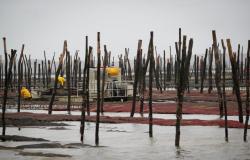
When John F. Kennedy inaugurated the Flaming Gorge Dam in northern Utah with great fanfare in 1963, he made it a political instrument. Seeing these 150 meter high walls reshape the landscape, we can imagine the pride of the Democratic president. However, as dizzying as it is, this monumental hydraulic infrastructure only offers fragile promises. From 1922, when its annual flow was distributed between seven American states and Mexico, the quantity of water supplied by the structure was overestimated by 25% compared to reality.
“It is on these bases of water availability that the southwest of the United States was built”explains the American photographer John Trotter, who has been documenting the consequences of the profound alteration of Colorado for twenty years. This long investigation took him from the west of the United States to the northwest of Mexico, where he became interested in overconsumption of water in California, changes in biodiversity along the river and agriculture. who depends on it.
More recently, he has focused on how Colorado beneficiaries are coping with the dramatic decline in its level. “There could be open conflict between states over water at some point, because no one would exist without it”he analyzes. From manna, the river has become the bane of political leaders.
Glaring contrast
Colorado provides water and electricity to more than 40 million Americans and supports agricultural production that powers the rest of the country. However, scientists estimate that its flow has decreased by around 20% compared to the 20th century.e century. The worst scenarios even project a further decline of 20% by 2050. At the level of the seven states which depend on its supply, this new situation weighs on the electoral campaign for the presidential election of November 5. “California does not provide water but it is the state that consumes the most. This creates strong resentment in Wyoming”remarks the photographer.
Follow our live | Live, American presidential election 2024: what are the polls saying four days before the election? Ask your questions to Mathieu Gallard, research director at Ipsos
Read later
In his images, the contrast is obvious. On one side, Arizona, Nevada and California. On the other, Colorado, New Mexico, Utah and Wyoming. Downstream, a population disconnected from the water, which crisscrosses its lakes by motorboat and waters its golf courses and public gardens liberally. Upstream, a rural area made of snow, hunting and fishing, which stores water from the generously snow-capped Rocky Mountains. Here and there, graffiti denounce Joe Biden's environmental policy.
You have 39.55% of this article left to read. The rest is reserved for subscribers.





